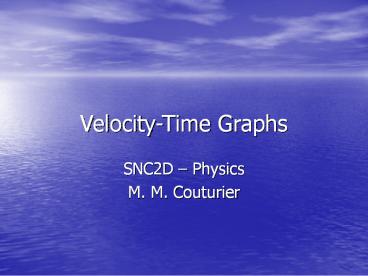Velocity-Time Graphs PowerPoint PPT Presentation
Title: Velocity-Time Graphs
1
Velocity-Time Graphs
- SNC2D Physics
- M. M. Couturier
2
Velocity-Time Graphs
- As the term suggests, a velocity-time graph is a
graph where velocity is plotted on the y-axis and
time is plotted on the x-axis.
3
Velocity-Time Graphs
- Since acceleration is related to velocity and
time (m/s2), the slope of the function will
reveal the average acceleration.
4
Velocity-Time Graphs
- As we did with position-time graphs, we need to
understand the nature of the acceleration so we
must understand all four kinds of slopes
increasing, decreasing, and zero (within this new
context).
5
Velocity-Time Graphs
- This is an example of a zero slope. The change
in velocity here is ?v 0 over a period of time,
t. The average acceleration is therefore - aavg ?v 0 0
- ?t t
- Essentially, the object is traveling at a
constant velocity.
6
Velocity-Time Graphs
- This is an example of an increasing slope. ?v
and ?t are both positive and therefore, aavg will
also be positive. Also, since it is a straight
line (linear), the acceleration is constant,
meaning the acceleration is the same.
7
Velocity-Time Graphs
- This is an example of a decreasing slope. ?v is
negative and since ?t can only be positive, aavg
will be negative. They are slowing down.
8
Velocity-Time Graphs
- Use this as an easy reference guide!!!
9
Velocity-Time Graphs
- Use this as an easy reference guide!!!
10
Velocity-Time Graphs
- In order to calculate the average acceleration
using a velocity-time graph, you need to isolate
two points on a single line. Look at the
velocity-time graph below and write down the
coordinates of any two points on the line.
11
Velocity-Time Graphs
- Since the average acceleration is defined by
- aavg ?v
- ?t
- The two points that we have selected provide both
?v and ?t.
12
Velocity-Time Graphs
- Lets say that you selected (t,v) as (4,8) and
(0,0). Your ?v (8-0) and your ?t (4-0),
hence - aavg ?v (8 0) 8
- ?t (4-0) 4
- aavg 2 m/s
- Does it matter which
- point you choose?
13
Velocity-Time Graphs
- Lets say that you selected (t,v) as (2,4) and
(1,2). Your ?v (4-2) and your ?t (2-1),
hence - aavg ?v (4 2) 2
- ?t (2-1) 1
- aavg 2 m/s
- Does it matter which
- point you choose? It does not matter!!!
14
Velocity-Time Graphs
- Again, never hesitate to draw on the graph that
is provided to you in the following manner.
15
Velocity-Time Graphs
- Okay lets describe qualitatively what is
happening in each of these situations.
16
Velocity-Time Graphs
- Red car Notice that the red car is moving at a
constant velocity. It is therefore not
accelerating.
17
Velocity-Time Graphs
- Green car Notice that the green car is
increasing in velocity and is therefore
accelerating. It is taking much more time to
accelerate than the blue car, but it will
eventually pass the red car.
18
Velocity-Time Graphs
- Blue car The blue car is also increasing in
velocity and is therefore accelerating. It is
accelerating at a faster rate than the green car.
19
Review of position-time graphs
- Which graph goes with which car?
20
Review of position-time graphs
- Which graph goes with which car?
- B
- C
- A
21
Lets bring it all together!!!
- Watch the graphs and the cars!!!
22
Lets bring it all together!!!
23
Lets bring it all together!!!
- The blue dot is being displaced equally each unit
of time ergo it is moving at a constant
velocity, ergo, it is not accelerating!
24
Lets bring it all together!!!
25
Lets bring it all together!!!
- The blue dot is being displaced equally each unit
of time ergo it is moving at a constant
velocity, ergo, it is not accelerating!
26
Lets bring it all together!!!
27
Lets bring it all together!!!
- The displacement of the blue dot is larger after
each unit of time. It is therefore increasing in
velocity, which is increasing equally each unit
of time ergo it is accelerating at a constant
rate.
28
Lets bring it all together!!!
29
Lets bring it all together!!!
- The displacement of the blue dot is smaller after
each unit of time. It is therefore decreasing in
velocity, which is decreasing equally each unit
of time ergo it is accelerating at a negative
constant rate.
30
Velocity-Time Graphs
- Task 1 Look at the graph below and determine
the aaverage in each case and then write a short
story to explain the events. Be creative.
31
Velocity-Time Graphs
- Task 2 Look at the graph below and determine
the aaverage in each case and then write a short
story to explain the events. Be creative.
32
Velocity-Time Graphs
- Lets do a test
- http//www.explorelearning.com/index.cfm?methodcR
esource.dspViewResourceID301

